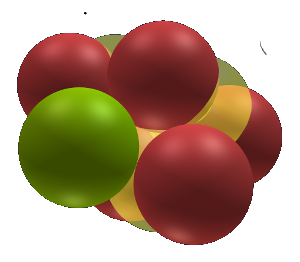Further growing the nucleus
After carbon, the growth pattern changes, it has to change. Other models with nested geometries, which put a geometric structure into another one run into problems very fast, the structures do not make sense when related to elements and their properties. Another solution is required. It presents itself already with the next element after carbon: nitrogen. Adding the next deuteron on top of the icosahedron creates a gap in the icosahedron structure, it is distorted. The icosahedron is opened up at a specific place, it therefore gains directionality. Recognizing this distortion and its consequences led to the idea of two connection points on one side of the icosahedron, based on wherever the first deuteron attaches to create nitrogen from carbon. Those first two connection points on the initial icosahedron show an unusual vertical angle of ~31.5° each (because of the top-gap distortion). A connecting tetrahedron is tilted and simultaneously rotated by 36°.
This figure shows the structure of neon-20 as an example. The two growth points on the icosahedron are visible through the additional deuterons (green) – two on each side. As a consequence the structure starts to branch, and repeats the dense packing pattern until the icosahedron shape is reached again. We find that this way a backbone of carbon nuclets is grown that makes up the majority of the structure of every nucleus. The connection is made through a shared proton, the connecting icosahedrons provide therefore only 5 deuterons and a single proton which equals 11 nucleons (instead of 12 on the initial icosahedron).
- Two-ending (green)
- Four-ending (green)
- Five-ending (green+yellow) = Four-ending with an additional PEP
- Lithium nuclet (red)
- Beryllium ending (orange)
- Boron ending (purple)
- Carbon nuclet (blue)
- Initial ending (bluish)
- Final ending (white)
The figure above is a fictional atomic nucleus featuring a carbon backbone as well as all active structures on top of it. We call those active structures generally “endings” and divide them further into “cappings” and “nuclets.” The colors are there just to highlight the groupings of protons. Cappings are the first step of growth after a new carbon (icosahedron) has been created. They are represented by a two-ending (one deuteron), a four-ending (two deuterons in a squashed tetrahedron configuration) and a five-ending (one four-ending plus a PEP). If all active endings of the icosahedrons of a nucleus are capped by four- or five-endings, then the element is noble. After the capping phase on a growth point ends, the building phase begins, which starts with a lithium structure (three deuterons) and ends with a carbon (five deuterons and a single proton). The in-between steps are named after beryllium (four deuterons) and boron (five deuterons). We only use the term nuclet for the start (lithium) and the end (carbon) of the building phase. For the other stages only “ending” is used. The term “nuclet” is new and was coined by us, to better categorize those unique building blocks.


